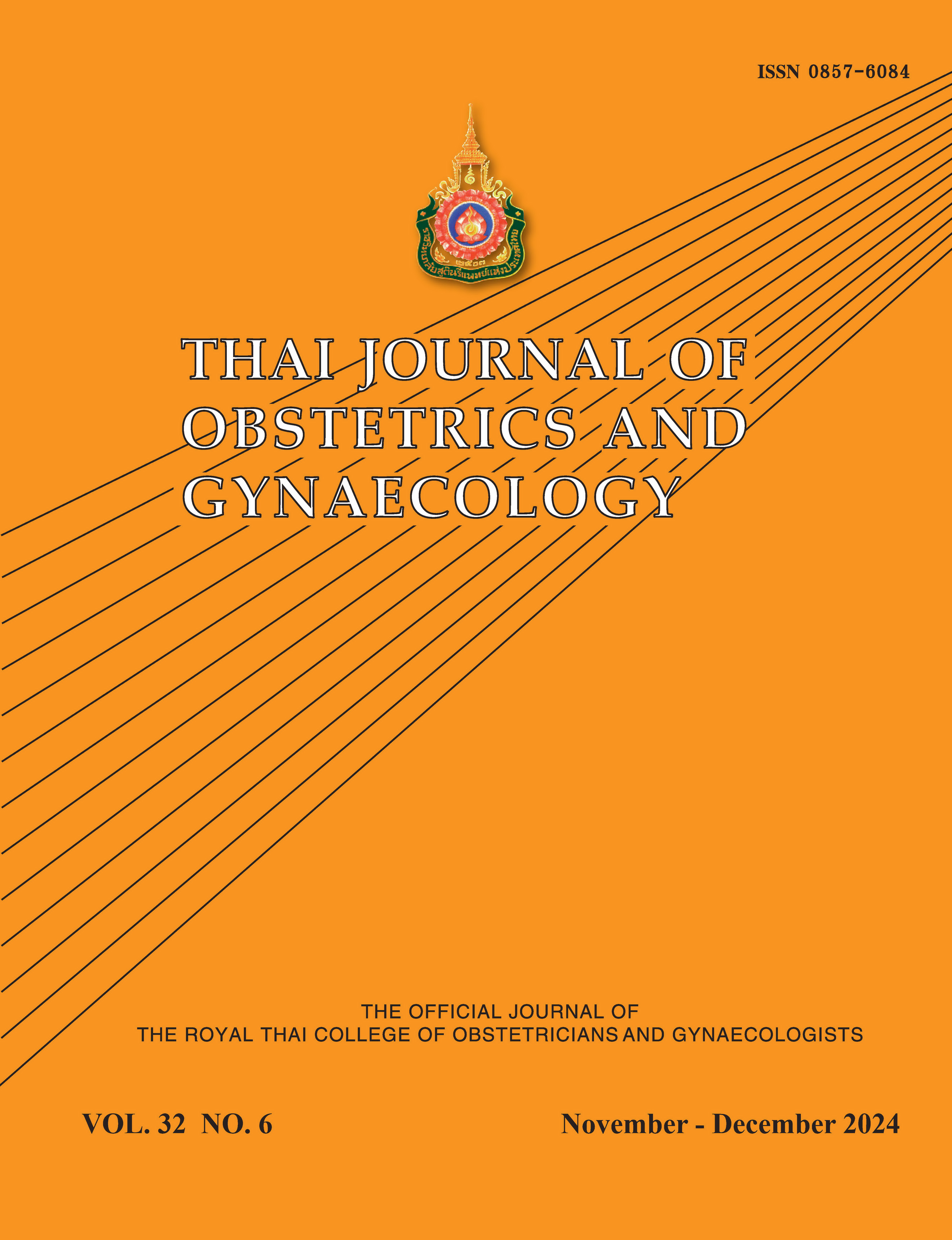The Incidence and Risk Factors of Obstetrics anal Sphincter Injuries at King Chulalongkorn Memorial Hospital during 2017-2019
Main Article Content
Abstract
Objectives: To study the incidence and risk factors of OASIS during 1 January 2017 to 31 December 2019
Materials and Methods: A retrospective study of all pregnant woman with vaginal delivery (6,714 cases) at King Chulalongkorn Memorial Hospital during 2017-2019 were conducted. We collected the data of all pregnant women who delivered in our hospital since 1 January 2017 to 31 December 2019, using International Classification of Diseases, Tenth Revision (ICD 10) codes for data extraction and review. The case group comprised of pregnant women with an OASIS (third- degree and fourth-degree perineal laceration). The control group comprised of pregnant women delivered vaginally without OASIS.
Results: The incidence of OASIS was 6% (403/6,714). The significant risk factors are nulliparity vs multiparity (adjusted odds ratio (aOR) 3.0, 95% confidence interval (CI) 2.3-4.0, p < 0.01), obesity vs normal BMI (aOR 0.5, 95%CI 0.3-0.7, p < 0.01), forceps extraction vs spontaneous delivery (aOR 4.5, 95% CI 3.1-6.5, p < 0.01), occiput posterior vs occiput anterior position (aOR 2.3, 95%CI 1.2-4.3, p = 0.01), median episiotomy vs no episiotomy (aOR 2.3, 95%CI 1.3-4.3, p = 0.01), staff vs nurses (aOR 11.1, 95%CI 5.0-25.0, p < 0.01), residents vs nurses (aOR 13.3, 95%CI 5.9-30.2, p < 0.01), and medical student vs nurses (aOR 3.5, 95%CI 1.3-9.6, p = 0.01).
Conclusion: The risk factors of OASIS were nulliparity, occiput posterior postition, forceps extraction, median episiotomy, residents and staffs (as the operators). The protective factors were obesity and nurses. Preventive strategies for these factors are advocated.
Article Details

This work is licensed under a Creative Commons Attribution-NonCommercial-NoDerivatives 4.0 International License.
References
Sultan AH, Monga A, Lee J, Emmanuel A, Norton C, Santoro G,et al. An International Urogynecological Association (IUGA)/International Continence Society (ICS) joint report on the terminology for female anorectal dysfunction. Int Urogynecol J 2017;28:5-31.
Fornell EU, Matthiesen L, Sjödahl R, Berg G. Obstetric anal sphincter injury ten years after: subjective and objective long-term effects. BJOG 2005;112:312-6.
Tung CW, Cheon WC, Tong WMA, Leung HY. Incidence and risk factors of obstetric anal sphincter injuries after various modes of vaginal deliveries in Chinese women. Chin Med J (Engl) 2015;128: 2420–5.
Meister MRL, Cahill AG, Conner SN, Woolfolk CL, Lowder JL. Predicting obstetric anal sphincter injuries in a modern obstetric population. Am J Obstet Gynecol 2016;215:310.e1-7.
Gundabattula SR, Surampudi K. Risk factors for obstetric anal sphincter injuries (OASI) at a tertiary centre in south India. Int Urogynecol J 2018;29: 391–6.
Djaković I, Ejubović E, Bolanča I, Markuš-Sandrić M, Bečić D, Djaković Ž, et al. Third and fourth degree perineal tear in four-year period at Sestre Milosrdnice University Hospital Center, Zagreb, Croatia. Open Access Maced J Med Sci 2018;6:1067–71.
Mahgoub S, Piant H, Gaudineau A, Lefebvre F, Langer B, Koch A. Risk factors for obstetric anal sphincter injuries (OASIS) and the role of episiotomy: A retrospective series of 496 cases. J Gynecol Obstet Hum Reprod 2019;48:657–62.
Thubert T, Cardaillac C, Fritel X, Winer N, Dochez V. Definition, epidemiology and risk factors of obstetric anal sphincter injuries: CNGOF Perineal Prevention and Protection in Obstetrics Guidelines. Gynecol Obstet Fertil Senol 2018;46:913–21.
Royal College of Obstetricians and Gynecologists (RCOG). The management of third and fourth- degree perineal tears, green-top guideline No.29, June 2015.
Hartmann K, Viswanathan M, Palmieri R, Gartlehner G, Thorp J Jr, Lohr KN. Outcomes of routine episiotomy: a systematic review. JAMA 2005;293: 2141-8.


